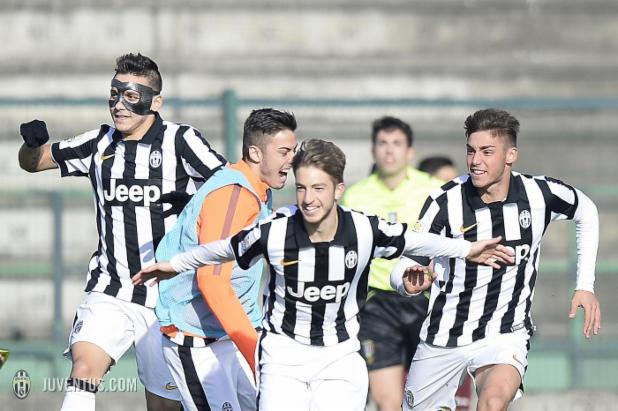Primavera & Allievi 2014-15 (1 Viewer)
- Thread starter JuveJay
- Start date
- Status
- Not open for further replies.
More options
Who Replied?
0-3  not doing well in the Primavera Campionato either... needs an overhaul imo, Juve's Primavera is nowhere near the youth of the other European elites but not even among the best in Italy is worrisome. No wonder we don't have too many promoted from the Primavera to the 1st team squad.
not doing well in the Primavera Campionato either... needs an overhaul imo, Juve's Primavera is nowhere near the youth of the other European elites but not even among the best in Italy is worrisome. No wonder we don't have too many promoted from the Primavera to the 1st team squad.
 not doing well in the Primavera Campionato either... needs an overhaul imo, Juve's Primavera is nowhere near the youth of the other European elites but not even among the best in Italy is worrisome. No wonder we don't have too many promoted from the Primavera to the 1st team squad.
not doing well in the Primavera Campionato either... needs an overhaul imo, Juve's Primavera is nowhere near the youth of the other European elites but not even among the best in Italy is worrisome. No wonder we don't have too many promoted from the Primavera to the 1st team squad.
Truth is Juve youth ranks and mainly Juve Primavera are failling miserably despite a record sum of 8M being spent annually on it with lots of foreigners being bought.
Primavera has been doing badly both in Italy and in Europe where it's been embarassed constantly.
It looks like mainly the coaches chosen have been of very poor performance. Pesotto is the one who commands the youth ranks, choosing the staff, and he should be let go ASAP. The management has been very bad, despite some very interesting individual talents. But team's organization and player's confidence is non existant.
Primavera has been doing badly both in Italy and in Europe where it's been embarassed constantly.
It looks like mainly the coaches chosen have been of very poor performance. Pesotto is the one who commands the youth ranks, choosing the staff, and he should be let go ASAP. The management has been very bad, despite some very interesting individual talents. But team's organization and player's confidence is non existant.
Truth is Juve youth ranks and mainly Juve Primavera are failling miserably despite a record sum of 8M being spent annually on it with lots of foreigners being bought.
Primavera has been doing badly both in Italy and in Europe where it's been embarassed constantly.
It looks like mainly the coaches chosen have been of very poor performance. Pesotto is the one who commands the youth ranks, choosing the staff, and he should be let go ASAP. The management has been very bad, despite some very interesting individual talents. But team's organization and player's confidence is non existant.
Primavera has been doing badly both in Italy and in Europe where it's been embarassed constantly.
It looks like mainly the coaches chosen have been of very poor performance. Pesotto is the one who commands the youth ranks, choosing the staff, and he should be let go ASAP. The management has been very bad, despite some very interesting individual talents. But team's organization and player's confidence is non existant.
For me the side we played with yesterday isn't even our strongest line up, but the coaches are there to give all players as many games as possible and exposure to pressure situations and strong opponents.
The litmus test for youth teams are the players they produce, for our team or to sell others. It's still a bit too early to fully judge the work we have been doing over the last 3-4 years with Paratici, Vargas, Pessotto and co, but it's a very mixed bag of successes and failures.
- - - Updated - - -
Do transfer limitations (i.e. only 2 non-Eu players a season) apply for the primavera too?
Of the African players we have most have been here since an early age, you can go through the current teams below U15 and see examples.
I believe there is also a restriction in signing under 18 players from South America.
The performance of the team is not really of the most importance, usually they go hand in hand with quality players, but not always. It's not like the first team where we want results, we need player development here.
For me the side we played with yesterday isn't even our strongest line up, but the coaches are there to give all players as many games as possible and exposure to pressure situations and strong opponents.
The litmus test for youth teams are the players they produce, for our team or to sell others. It's still a bit too early to fully judge the work we have been doing over the last 3-4 years with Paratici, Vargas, Pessotto and co, but it's a very mixed bag of successes and failures.
- - - Updated - - -
I'm not 100% sure but there are almost certainly are limitations. When we brought the Appelts they had Portuguese passports. Bnou-Marzouk has a French one. Cevallos is the only one I can think of who certainly didn't have an EU passport. We are also looking for Pochettino (Boca) to get his Italian one.
Of the African players we have most have been here since an early age, you can go through the current teams below U15 and see examples.
I believe there is also a restriction in signing under 18 players from South America.
For me the side we played with yesterday isn't even our strongest line up, but the coaches are there to give all players as many games as possible and exposure to pressure situations and strong opponents.
The litmus test for youth teams are the players they produce, for our team or to sell others. It's still a bit too early to fully judge the work we have been doing over the last 3-4 years with Paratici, Vargas, Pessotto and co, but it's a very mixed bag of successes and failures.
- - - Updated - - -
I'm not 100% sure but there are almost certainly are limitations. When we brought the Appelts they had Portuguese passports. Bnou-Marzouk has a French one. Cevallos is the only one I can think of who certainly didn't have an EU passport. We are also looking for Pochettino (Boca) to get his Italian one.
Of the African players we have most have been here since an early age, you can go through the current teams below U15 and see examples.
I believe there is also a restriction in signing under 18 players from South America.
Well that's exactly what I'm talking about. As teams are poorly coached, it also hinders players development. We are certainly lacking it.
Who is Zorro??


Zorro (/ˈzɔːroʊ/; Spanish: [ˈθoro], American Spanish: [ˈsoro]) is a character created in 1919 by New York–based pulp writer Johnston McCulley. The character has been featured in numerous books, films, television series, and other media. Zorro (Spanish for "fox") is the secret identity of Don Diego de la Vega, a California nobleman living in Los Angeles during the era of Spanish rule.
The character has undergone changes through the years, but the typical image of him is a dashing black-clad masked outlaw who defends the people of the land against tyrannical officials and other villains. Not only is he too cunning and foxlike for the bumbling authorities to catch, but also delights in publicly humiliating them.
Publishing history[edit]
Zorro debuted in McCulley's 1919 story "The Curse of Capistrano", serialized in five parts in the pulp magazine All-Story Weekly.[1] At the denouement, Zorro's true identity is revealed to all.
Douglas Fairbanks and Mary Pickford, on their honeymoon, selected the story as the inaugural picture for their new studio, United Artists, beginning the character's cinematic tradition. The story was adapted as the film The Mark of Zorro (1920), which was a commercial success. McCulley's story was rereleased by publisher Grosset & Dunlap under the same title, to tie in with the film.
In response to public demand fueled by the film, McCulley wrote more than sixty more Zorro stories, beginning in 1922. The last, "The Mask of Zorro" (not to be confused with the 1998 film), was published posthumously in 1959. These stories ignore Zorro's public revelation of his identity. McCulley died in 1958, just as the Disney-produced Zorro television show was becoming popular.
Fictional character biography[edit]
The Mark of Zorro, starring Douglas Fairbanks, the first Zorro film, was instrumental in the early success of the character
In "The Curse of Capistrano", Don Diego Vega becomes Señor Zorro in the pueblo of Los Angeles in California "to avenge the helpless, to punish cruel politicians", and "to aid the oppressed." He is the title character, as he is dubbed the "Curse of Capistrano."
The story involves him romancing Lolita Pulido, an impoverished noblewoman. While Lolita is unimpressed with Diego, who pretends to be a passionless fop, she is attracted to the dashing Zorro. His rival is Captain Ramon. Other characters include Sgt. Pedro Gonzales, Zorro's enemy but Diego's friend; Zorro's deaf and mute servant Bernardo; his ally Fray (Friar) Felipe; his father Don Alejandro Vega; and a group of noblemen (caballeros) who at first hunt him but are won over to his cause.
In later stories, McCulley introduces characters such as pirates and Native Americans, some of whom know Zorro's identity.
In McCulley's later stories, Diego's surname became de la Vega. In fact, the writer was wildly inconsistent. The first magazine serial ended with the villain dead and Diego publicly exposed as Zorro, but in the sequel the villain was alive, and the next entry had the double identity still secret.
Several Zorro productions have expanded on the character's exploits. Many of the continuations feature a younger character taking up the mantle of Zorro.
Although McCulley's stories were set in Los Angeles during the era of Mexican rule (between 1821 and 1846), some movie adaptations of Zorro's story have placed him during the earlier Spanish era.
Characteristics[edit]
In "The Curse of Capistrano", Diego is described as "unlike the other full-blooded youths of the times"; though proud as befitting his class (and seemingly uncaring about the lower classes), he shuns action, rarely wearing his sword except for fashion, and is indifferent to romance with women. This is, of course, a sham. This portrayal, with minor variations, is followed in most Zorro media.
A notable exception to this portrayal is Disney's Zorro (1957–59), where Diego, despite using the original facade early in the series, instead becomes a passionate and compassionate crusader for justice and simply masquerades as "the most inept swordsman in all of California." In this show, everyone knows Diego would love to do what Zorro does, but thinks he does not have the skill.
The Family Channel's Zorro (1990–1993) takes this concept further. While Diego pretends to be inept with a sword, the rest of his facade is actually exaggerating his real interests. Diego is actually well versed and interested in art, poetry, literature, and science. His facade is pretending to only be interested in these things and to have no interest in swordplay or action. Zorro also has a well-equipped laboratory in his hidden cave in this version of the story.
Character motifs[edit]
The character's visual motif is typically a black costume with a flowing Spanish cape, a flat-brimmed black sombrero cordobés, and a black cowl sackcloth domino mask that covers the top of the head from eye level upwards. In his first appearance, he wears a cloak instead of a cape, and a black cloth veil mask with slits for eyes covers his whole face. Other features of the costume may vary.
His favored weapon is a rapier, which he often uses to leave his distinctive mark, a Z cut with three quick strokes. He also uses a bullwhip. In his debut, he uses a pistol.
The fox is never depicted as Zorro's emblem. It is used as a metaphor for the character's wiliness, such as in the lyrics "Zorro, 'the Fox', so cunning and free ..." from the Disney television show theme.
His heroic pose consists of rearing on his horse Toronado/Tornado, sword raised high. (The logo of Zorro Productions, Inc. uses an example of this pose.)
Skills and resources[edit]
Zorro (Guy Williams) and Bernardo (Gene Sheldon) in the 1950s Zorro television series
Zorro is an agile athlete and acrobat, using his bullwhip as a gymnastic accoutrement to swing through gaps between city roofs, and is very capable of landing from great heights and taking a fall. Although he is a master swordsman and marksman, he has more than once demonstrated his prowess in unarmed combat against multiple opponents.
His calculating and precise dexterity as a tactician has enabled him to use his two main weapons, his sword and bullwhip, as an extension of his deft hand. He never uses brute strength, more his fox-like sly mind and well-practiced technique to outmatch an opponent.
In some versions, Zorro keeps a medium-sized dagger tucked in his left boot for emergencies. He has used his cape as a blind, a trip-mat and a disarming tool. Zorro's boots are also sometimes weighted, as is his hat, which he has thrown, Frisbee-style, as an efficiently substantial warning to enemies. But more often than not, he uses psychological mockery to make his opponents too angry to be coordinated in combat.
Zorro is a skilled horseman. The name of his jet-black horse has varied through the years. In "The Curse of Capistrano", it was unnamed. Later versions named the horse Toronado/Tornado or Tempest. In other versions, Zorro rides a white horse named Phantom.
McCulley's concept of a band of men helping Zorro is often absent from other versions of the character. An exception is Zorro's Fighting Legion (1939), starring Reed Hadley as Diego. In Douglas Fairbanks' version, he also has a band of masked men helping him. In McCulley's stories, Zorro was aided by a deaf-mute named Bernardo. In Disney's Zorro television series, Bernardo is not deaf but pretends to be, and serves as Zorro's spy. He is a capable and invaluable helper for Zorro, sometimes wearing the mask to reinforce his master's charade. The Family Channel's Zorro television series replaces Bernardo with a teenager named Felipe, played by Juan Diego Botto, with a similar disability and pretense.
Inspirations[edit]
The historical figure most often associated with the Zorro character is Joaquin Murrieta, whose life was fictionalized in an 1854 dime novel by John Rollin Ridge. In the 1998 film The Mask of Zorro Murrieta's (fictive) brother Alejandro succeeds Diego as Zorro. As a hero with a secret identity who taunts his foes by signing his deeds, Zorro finds a direct literary predecessor in Sir Percival Blakeney, hero of the Scarlet Pimpernel pulp series by Baroness Emmuska Orczy.
The character recalls other figures, such as Robin Hood, Reynard the Fox, Salomon Pico, Manuel Rodríguez Erdoíza, and Tiburcio Vasquez. Another possible historical inspiration is William Lamport, an Irish soldier who lived in Mexico in the seventeenth century. His life was the subject of a fictive book by Vicente Riva Palacio; The Irish Zorro (2004) is a recent biography. Another is Estanislao, a Yokuts man who led a revolt against the Mission San Jose in 1827.
The 1890s penny dreadful treatment of the Spring Heeled Jack character as a masked avenger may have inspired some aspects of Zorro's heroic persona. Spring Heeled Jack was portrayed as a nobleman who created a flamboyant, masked alter ego to fight injustice, frequently demonstrated exceptional athletic and combative skills, maintained a hidden lair and was known to carve the letter "S" into walls with his rapier as a calling card.
Like Sir Percy in The Scarlet Pimpernel, Don Diego avoids suspicion by playing the role of a dandy who wears lace, writes poetry, and shuns violence. The all-black Fairbanks film costume, which with variations has remained the standard costume for the character, was likely adapted from the Arrow serial film character The Masked Rider (1919). This character was the first Mexican black-clad masked rider on a black horse to appear on the silver screen. Fairbanks's costume in The Mark of Zorro, released the following year, resembled that of the Rider with only slight differences in the mask and hat.
The character has undergone changes through the years, but the typical image of him is a dashing black-clad masked outlaw who defends the people of the land against tyrannical officials and other villains. Not only is he too cunning and foxlike for the bumbling authorities to catch, but also delights in publicly humiliating them.
Publishing history[edit]
Zorro debuted in McCulley's 1919 story "The Curse of Capistrano", serialized in five parts in the pulp magazine All-Story Weekly.[1] At the denouement, Zorro's true identity is revealed to all.
Douglas Fairbanks and Mary Pickford, on their honeymoon, selected the story as the inaugural picture for their new studio, United Artists, beginning the character's cinematic tradition. The story was adapted as the film The Mark of Zorro (1920), which was a commercial success. McCulley's story was rereleased by publisher Grosset & Dunlap under the same title, to tie in with the film.
In response to public demand fueled by the film, McCulley wrote more than sixty more Zorro stories, beginning in 1922. The last, "The Mask of Zorro" (not to be confused with the 1998 film), was published posthumously in 1959. These stories ignore Zorro's public revelation of his identity. McCulley died in 1958, just as the Disney-produced Zorro television show was becoming popular.
Fictional character biography[edit]
The Mark of Zorro, starring Douglas Fairbanks, the first Zorro film, was instrumental in the early success of the character
In "The Curse of Capistrano", Don Diego Vega becomes Señor Zorro in the pueblo of Los Angeles in California "to avenge the helpless, to punish cruel politicians", and "to aid the oppressed." He is the title character, as he is dubbed the "Curse of Capistrano."
The story involves him romancing Lolita Pulido, an impoverished noblewoman. While Lolita is unimpressed with Diego, who pretends to be a passionless fop, she is attracted to the dashing Zorro. His rival is Captain Ramon. Other characters include Sgt. Pedro Gonzales, Zorro's enemy but Diego's friend; Zorro's deaf and mute servant Bernardo; his ally Fray (Friar) Felipe; his father Don Alejandro Vega; and a group of noblemen (caballeros) who at first hunt him but are won over to his cause.
In later stories, McCulley introduces characters such as pirates and Native Americans, some of whom know Zorro's identity.
In McCulley's later stories, Diego's surname became de la Vega. In fact, the writer was wildly inconsistent. The first magazine serial ended with the villain dead and Diego publicly exposed as Zorro, but in the sequel the villain was alive, and the next entry had the double identity still secret.
Several Zorro productions have expanded on the character's exploits. Many of the continuations feature a younger character taking up the mantle of Zorro.
Although McCulley's stories were set in Los Angeles during the era of Mexican rule (between 1821 and 1846), some movie adaptations of Zorro's story have placed him during the earlier Spanish era.
Characteristics[edit]
In "The Curse of Capistrano", Diego is described as "unlike the other full-blooded youths of the times"; though proud as befitting his class (and seemingly uncaring about the lower classes), he shuns action, rarely wearing his sword except for fashion, and is indifferent to romance with women. This is, of course, a sham. This portrayal, with minor variations, is followed in most Zorro media.
A notable exception to this portrayal is Disney's Zorro (1957–59), where Diego, despite using the original facade early in the series, instead becomes a passionate and compassionate crusader for justice and simply masquerades as "the most inept swordsman in all of California." In this show, everyone knows Diego would love to do what Zorro does, but thinks he does not have the skill.
The Family Channel's Zorro (1990–1993) takes this concept further. While Diego pretends to be inept with a sword, the rest of his facade is actually exaggerating his real interests. Diego is actually well versed and interested in art, poetry, literature, and science. His facade is pretending to only be interested in these things and to have no interest in swordplay or action. Zorro also has a well-equipped laboratory in his hidden cave in this version of the story.
Character motifs[edit]
The character's visual motif is typically a black costume with a flowing Spanish cape, a flat-brimmed black sombrero cordobés, and a black cowl sackcloth domino mask that covers the top of the head from eye level upwards. In his first appearance, he wears a cloak instead of a cape, and a black cloth veil mask with slits for eyes covers his whole face. Other features of the costume may vary.
His favored weapon is a rapier, which he often uses to leave his distinctive mark, a Z cut with three quick strokes. He also uses a bullwhip. In his debut, he uses a pistol.
The fox is never depicted as Zorro's emblem. It is used as a metaphor for the character's wiliness, such as in the lyrics "Zorro, 'the Fox', so cunning and free ..." from the Disney television show theme.
His heroic pose consists of rearing on his horse Toronado/Tornado, sword raised high. (The logo of Zorro Productions, Inc. uses an example of this pose.)
Skills and resources[edit]
Zorro (Guy Williams) and Bernardo (Gene Sheldon) in the 1950s Zorro television series
Zorro is an agile athlete and acrobat, using his bullwhip as a gymnastic accoutrement to swing through gaps between city roofs, and is very capable of landing from great heights and taking a fall. Although he is a master swordsman and marksman, he has more than once demonstrated his prowess in unarmed combat against multiple opponents.
His calculating and precise dexterity as a tactician has enabled him to use his two main weapons, his sword and bullwhip, as an extension of his deft hand. He never uses brute strength, more his fox-like sly mind and well-practiced technique to outmatch an opponent.
In some versions, Zorro keeps a medium-sized dagger tucked in his left boot for emergencies. He has used his cape as a blind, a trip-mat and a disarming tool. Zorro's boots are also sometimes weighted, as is his hat, which he has thrown, Frisbee-style, as an efficiently substantial warning to enemies. But more often than not, he uses psychological mockery to make his opponents too angry to be coordinated in combat.
Zorro is a skilled horseman. The name of his jet-black horse has varied through the years. In "The Curse of Capistrano", it was unnamed. Later versions named the horse Toronado/Tornado or Tempest. In other versions, Zorro rides a white horse named Phantom.
McCulley's concept of a band of men helping Zorro is often absent from other versions of the character. An exception is Zorro's Fighting Legion (1939), starring Reed Hadley as Diego. In Douglas Fairbanks' version, he also has a band of masked men helping him. In McCulley's stories, Zorro was aided by a deaf-mute named Bernardo. In Disney's Zorro television series, Bernardo is not deaf but pretends to be, and serves as Zorro's spy. He is a capable and invaluable helper for Zorro, sometimes wearing the mask to reinforce his master's charade. The Family Channel's Zorro television series replaces Bernardo with a teenager named Felipe, played by Juan Diego Botto, with a similar disability and pretense.
Inspirations[edit]
The historical figure most often associated with the Zorro character is Joaquin Murrieta, whose life was fictionalized in an 1854 dime novel by John Rollin Ridge. In the 1998 film The Mask of Zorro Murrieta's (fictive) brother Alejandro succeeds Diego as Zorro. As a hero with a secret identity who taunts his foes by signing his deeds, Zorro finds a direct literary predecessor in Sir Percival Blakeney, hero of the Scarlet Pimpernel pulp series by Baroness Emmuska Orczy.
The character recalls other figures, such as Robin Hood, Reynard the Fox, Salomon Pico, Manuel Rodríguez Erdoíza, and Tiburcio Vasquez. Another possible historical inspiration is William Lamport, an Irish soldier who lived in Mexico in the seventeenth century. His life was the subject of a fictive book by Vicente Riva Palacio; The Irish Zorro (2004) is a recent biography. Another is Estanislao, a Yokuts man who led a revolt against the Mission San Jose in 1827.
The 1890s penny dreadful treatment of the Spring Heeled Jack character as a masked avenger may have inspired some aspects of Zorro's heroic persona. Spring Heeled Jack was portrayed as a nobleman who created a flamboyant, masked alter ego to fight injustice, frequently demonstrated exceptional athletic and combative skills, maintained a hidden lair and was known to carve the letter "S" into walls with his rapier as a calling card.
Like Sir Percy in The Scarlet Pimpernel, Don Diego avoids suspicion by playing the role of a dandy who wears lace, writes poetry, and shuns violence. The all-black Fairbanks film costume, which with variations has remained the standard costume for the character, was likely adapted from the Arrow serial film character The Masked Rider (1919). This character was the first Mexican black-clad masked rider on a black horse to appear on the silver screen. Fairbanks's costume in The Mark of Zorro, released the following year, resembled that of the Rider with only slight differences in the mask and hat.
We have good talent at the youth ranks, but it has been mismanaged.
Talent is there: Romagna, Pellini, Macek, Sakor, Vitale, Clemenza, Donis, Bnou-Marzouk, Buenacasa, Kastanos.
The problem is that Paratici broought in too many kids. The squad is too big, there's a lot of rotation to do and guys don't play constantly enough.
But the main problem is the lack of skills by the staff. Coaches just can't form solid 11s, and can't develop the players. They always get worse from allievi to Primavera, and from 1st primavera year to 2nd primavera year.
Sakor is a good example. The kid was wanted by all big European clubs. Chelsea, Arsenal, etc. We got him. He started really well. Then he was lost into the coaching insecurity, bad results on the pitch and he's been misused and stopped progressing for more than one year now.
Donis is exactly the same. A very talented winger who didn't develop. Actually he got worse.
Misguidance and mismanagement of talented young players is the greates problem. Pessotto is doing a poor job. Should let a real professional take care of the youth, not a guy just because he played for us. Fabio Grosso is the primavera head coach ffs, without any coaching experience.
Hopefully Marotta and Paratici will solve this out. We've spend a lot of money on young kids not to see they develop.
Talent is there: Romagna, Pellini, Macek, Sakor, Vitale, Clemenza, Donis, Bnou-Marzouk, Buenacasa, Kastanos.
The problem is that Paratici broought in too many kids. The squad is too big, there's a lot of rotation to do and guys don't play constantly enough.
But the main problem is the lack of skills by the staff. Coaches just can't form solid 11s, and can't develop the players. They always get worse from allievi to Primavera, and from 1st primavera year to 2nd primavera year.
Sakor is a good example. The kid was wanted by all big European clubs. Chelsea, Arsenal, etc. We got him. He started really well. Then he was lost into the coaching insecurity, bad results on the pitch and he's been misused and stopped progressing for more than one year now.
Donis is exactly the same. A very talented winger who didn't develop. Actually he got worse.
Misguidance and mismanagement of talented young players is the greates problem. Pessotto is doing a poor job. Should let a real professional take care of the youth, not a guy just because he played for us. Fabio Grosso is the primavera head coach ffs, without any coaching experience.
Hopefully Marotta and Paratici will solve this out. We've spend a lot of money on young kids not to see they develop.
- Status
- Not open for further replies.











